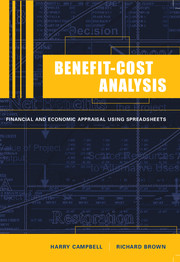Book contents
- Frontmatter
- Contents
- List of figures
- List of tables
- Preface
- Acknowledgements
- 1 Benefit-Cost Analysis: Introduction and Overview
- 2 Investment Appraisal: Principles
- 3 Investment Appraisal: Decision-Rules
- 4 Private Benefit-Cost Analysis: Financial Analysis
- 5 Efficiency Benefit-Cost Analysis
- 6 Calculating the Net Benefits to the Referent Group
- 7 Consumer and Producer Surplus in Benefit-Cost Analysis
- 8 Valuing Traded and Non-traded Commodities in Benefit-Cost Analysis
- 9 Incorporating Risk in Benefit-Cost Analysis
- 10 The Social Discount Rate, Cost of Public Funds, and the Value of Information
- 11 Weighting Net Benefits to Account for Income Distribution
- 12 Valuation of Non-marketed Goods
- 13 Economic Impact Analysis
- 14 Writing the Benefit-Cost Analysis Report
- Appendix 1 Case Study Assignment
- Appendix 2 Discount and Annuity Tables
- Index
5 - Efficiency Benefit-Cost Analysis
Published online by Cambridge University Press: 05 September 2012
- Frontmatter
- Contents
- List of figures
- List of tables
- Preface
- Acknowledgements
- 1 Benefit-Cost Analysis: Introduction and Overview
- 2 Investment Appraisal: Principles
- 3 Investment Appraisal: Decision-Rules
- 4 Private Benefit-Cost Analysis: Financial Analysis
- 5 Efficiency Benefit-Cost Analysis
- 6 Calculating the Net Benefits to the Referent Group
- 7 Consumer and Producer Surplus in Benefit-Cost Analysis
- 8 Valuing Traded and Non-traded Commodities in Benefit-Cost Analysis
- 9 Incorporating Risk in Benefit-Cost Analysis
- 10 The Social Discount Rate, Cost of Public Funds, and the Value of Information
- 11 Weighting Net Benefits to Account for Income Distribution
- 12 Valuation of Non-marketed Goods
- 13 Economic Impact Analysis
- 14 Writing the Benefit-Cost Analysis Report
- Appendix 1 Case Study Assignment
- Appendix 2 Discount and Annuity Tables
- Index
Summary
Introduction
In Chapter 1 it was suggested that the word “social” in “social benefit-cost analysis” has a rather restricted interpretation: it refers to the group whose costs and benefits are to be calculated and compared by means of the analysis. Often the referent group consists of all the residents of a country or State, but sometimes the definition is a narrower one. We have used the term “efficiency” cost-benefit analysis to refer to a study which calculates all the benefits and costs of a proposed project, irrespective of who gains or loses. A benefit-cost analysis from an efficiency perspective tells us whether the project is an efficient use of resources in the sense that the gainers from the project could, in principle, compensate the losers.
As noted in Chapter 1, a project makes a difference and the purpose of the benefit-cost analysis is to identify and measure that difference using the “with and without” approach. Each person who benefits from the project could, potentially, give up a sum of money so that she remains at the same level of economic welfare as she would have had without the project; these sums are money measures of the project benefits. Similarly, each person who bears a net cost as a result of the project could, potentially, be paid a sufficient sum to keep her at the same level of well-being as she would have had without the project; these sums are money measures of the project costs. If the sum of the monies which could notionally be collected from beneficiaries exceeds that required to compensate those who are affected adversely by the project then the project is an efficient allocation of resources according to an economic welfare criterion known as the Kaldor–Hicks criterion, as discussed in Chapter 1.
Information
- Type
- Chapter
- Information
- Benefit-Cost AnalysisFinancial and Economic Appraisal using Spreadsheets, pp. 92 - 121Publisher: Cambridge University PressPrint publication year: 2003
Accessibility standard: Unknown
Why this information is here
This section outlines the accessibility features of this content - including support for screen readers, full keyboard navigation and high-contrast display options. This may not be relevant for you.Accessibility Information
- 1
- Cited by
